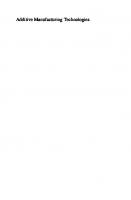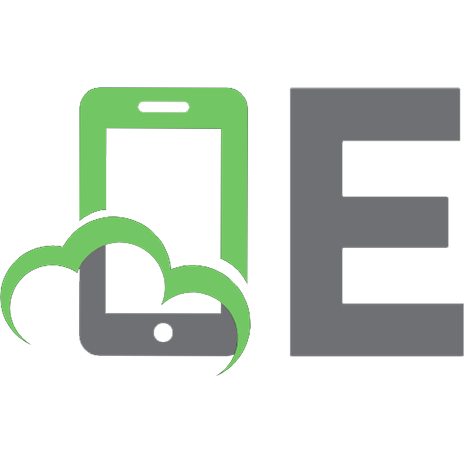Multi-dimensional Additive Manufacturing 9811579091, 9789811579097
In this book, basic sciences and applied technologies in 3D printing and 2D coating―including 2D surface modulations on
380 19 11MB
English Pages 175 [173] Year 2021
Table of contents :
Preface
Contents
Part ILithography
1 Selective Laser Melting
1.1 Laser Characteristics
1.2 Types of Lasers and Laser Absorption Coefficients
1.3 Types and Characteristics of 3D Layered Manufacturing Processes
1.4 Melt Pool Formation and Metal Laser Lamination Methods
1.5 Support Design in 3D Data and Measures to Remove Residual Stress
1.6 Control of Shape and Microstructure, and Formation of Single Crystalline with SLM
1.6.1 Shape Parameter and Its Hierarchy
1.7 Metal Products with SLM and Quality Management
References
2 Laser Processing for Metals
2.1 Processes
2.2 Advantages of Metal AM Processes
2.3 Issues and Approaches
2.3.1 Processing Time
2.3.2 Rough Surface and Internal Failures
2.3.3 Cost of Powder Material
2.3.4 Consideration of Heat History
2.4 Conclusion
References
3 Selective Electron Beam Melting
3.1 Structure of Selective Electron Beam Melting (SEBM)
3.2 SEBM Process
3.2.1 Atmosphere
3.2.2 Preheating
3.2.3 Raw Powder
3.2.4 Selective Melting Process
3.2.5 Stage Lowering Step
3.3 Conclusions
References
4 Current Research and Development
4.1 Investigation Method
4.2 Results and Discussion
4.3 Conclusion
References
5 Stereolithography
5.1 Three-Dimensional Printing
5.1.1 Laser Scanning Stereolithography
5.1.2 Micro-patterning Stereolithography
5.1.3 Ultraviolet Laser Lithography
5.2 Artificial Bone
5.2.1 Geometric Formation
5.2.2 Coordination Number
5.2.3 Biological Scaffold
5.3 Solid Oxide Fuel Cell
5.3.1 Energy Generation
5.3.2 Porous Structures
5.3.3 Dendritic Electrode
5.4 Photonic Crystal
5.4.1 Bandgap Formation
5.4.2 Periodic Arrangement
5.4.3 Dielectric Lattice
5.4.4 Electromagnetic Property
5.5 Conclusion
References
Part IINano/Micro Lamination
6 Chemical Vapor Deposition
6.1 Thermal CVD
6.2 High-Speed Deposition by Laser CVD
6.3 CVD for Deposition on Powder
6.4 Conclusion
References
7 Aqueous Solution Process
7.1 Development of SnO2 Nanomaterials [1]
7.2 SnO2 Nanosheet Assembled Film [12]
7.3 TiO2 Nanoneedle Assembled Film
7.4 ZnO Rod Array and ZnO Whisker Films [12]
7.5 Conclusions
References
Part IIICoating and Deposition
8 Aerosol Deposition Method
8.1 Characteristics and Deposition Mechanism of AD Method
8.2 Comparison of AD Method to Other Thin Film Technologies and Similar Spray Coating Processes
8.3 Thin Film Deposition by AD Method
8.3.1 Micro-patterning by AD Method
8.3.2 Large-Area Deposition by AD Method
8.4 Conclusion
References
9 Cold Sprayed Metal Coatings
9.1 Cold Spray and Its Basic Principle
9.2 Cold Spray Equipment
9.3 Advantages and Disadvantages of Cold Spray Process
9.4 Materials and Application Study Cases
9.5 Future Studies on Cold Spray
9.6 Summary
References
10 Cold Spray Technique
10.1 Metal Particle Deposition Mechanism
10.2 Examples of Ceramic Particle Deposition
10.3 Examples of Polymer Particle Deposition
10.4 Conclusions
References
11 Precursor Spray
11.1 History of Precursor Spray
11.2 Precursor Spray Equipment
11.3 Reaction Element Process of Reaction in PS
11.4 Case Study on Low Pressure PS
11.4.1 SiC Film Deposition
11.5 Case Studies of Atmospheric PS
11.5.1 Diamond Deposition by the Combustion Flame Method
11.5.2 Titanium Oxide Film Deposition by PS [21, 22]
11.6 Future Work
11.7 Conclusion
References
Preface
Contents
Part ILithography
1 Selective Laser Melting
1.1 Laser Characteristics
1.2 Types of Lasers and Laser Absorption Coefficients
1.3 Types and Characteristics of 3D Layered Manufacturing Processes
1.4 Melt Pool Formation and Metal Laser Lamination Methods
1.5 Support Design in 3D Data and Measures to Remove Residual Stress
1.6 Control of Shape and Microstructure, and Formation of Single Crystalline with SLM
1.6.1 Shape Parameter and Its Hierarchy
1.7 Metal Products with SLM and Quality Management
References
2 Laser Processing for Metals
2.1 Processes
2.2 Advantages of Metal AM Processes
2.3 Issues and Approaches
2.3.1 Processing Time
2.3.2 Rough Surface and Internal Failures
2.3.3 Cost of Powder Material
2.3.4 Consideration of Heat History
2.4 Conclusion
References
3 Selective Electron Beam Melting
3.1 Structure of Selective Electron Beam Melting (SEBM)
3.2 SEBM Process
3.2.1 Atmosphere
3.2.2 Preheating
3.2.3 Raw Powder
3.2.4 Selective Melting Process
3.2.5 Stage Lowering Step
3.3 Conclusions
References
4 Current Research and Development
4.1 Investigation Method
4.2 Results and Discussion
4.3 Conclusion
References
5 Stereolithography
5.1 Three-Dimensional Printing
5.1.1 Laser Scanning Stereolithography
5.1.2 Micro-patterning Stereolithography
5.1.3 Ultraviolet Laser Lithography
5.2 Artificial Bone
5.2.1 Geometric Formation
5.2.2 Coordination Number
5.2.3 Biological Scaffold
5.3 Solid Oxide Fuel Cell
5.3.1 Energy Generation
5.3.2 Porous Structures
5.3.3 Dendritic Electrode
5.4 Photonic Crystal
5.4.1 Bandgap Formation
5.4.2 Periodic Arrangement
5.4.3 Dielectric Lattice
5.4.4 Electromagnetic Property
5.5 Conclusion
References
Part IINano/Micro Lamination
6 Chemical Vapor Deposition
6.1 Thermal CVD
6.2 High-Speed Deposition by Laser CVD
6.3 CVD for Deposition on Powder
6.4 Conclusion
References
7 Aqueous Solution Process
7.1 Development of SnO2 Nanomaterials [1]
7.2 SnO2 Nanosheet Assembled Film [12]
7.3 TiO2 Nanoneedle Assembled Film
7.4 ZnO Rod Array and ZnO Whisker Films [12]
7.5 Conclusions
References
Part IIICoating and Deposition
8 Aerosol Deposition Method
8.1 Characteristics and Deposition Mechanism of AD Method
8.2 Comparison of AD Method to Other Thin Film Technologies and Similar Spray Coating Processes
8.3 Thin Film Deposition by AD Method
8.3.1 Micro-patterning by AD Method
8.3.2 Large-Area Deposition by AD Method
8.4 Conclusion
References
9 Cold Sprayed Metal Coatings
9.1 Cold Spray and Its Basic Principle
9.2 Cold Spray Equipment
9.3 Advantages and Disadvantages of Cold Spray Process
9.4 Materials and Application Study Cases
9.5 Future Studies on Cold Spray
9.6 Summary
References
10 Cold Spray Technique
10.1 Metal Particle Deposition Mechanism
10.2 Examples of Ceramic Particle Deposition
10.3 Examples of Polymer Particle Deposition
10.4 Conclusions
References
11 Precursor Spray
11.1 History of Precursor Spray
11.2 Precursor Spray Equipment
11.3 Reaction Element Process of Reaction in PS
11.4 Case Study on Low Pressure PS
11.4.1 SiC Film Deposition
11.5 Case Studies of Atmospheric PS
11.5.1 Diamond Deposition by the Combustion Flame Method
11.5.2 Titanium Oxide Film Deposition by PS [21, 22]
11.6 Future Work
11.7 Conclusion
References

- Author / Uploaded
- Soshu Kirihara
- Kazuhiro Nakata
- Similar Topics
- Technique
- industrial equipment and technology
![Multi-dimensional Additive Manufacturing [1st ed.]
9789811579097, 9789811579103](https://ebin.pub/img/200x200/multi-dimensional-additive-manufacturing-1st-ed-9789811579097-9789811579103.jpg)



![Industrializing Additive Manufacturing: Proceedings of AMPA2023 (Springer Tracts in Additive Manufacturing) [1st ed. 2024]
3031429826, 9783031429828](https://ebin.pub/img/200x200/industrializing-additive-manufacturing-proceedings-of-ampa2023-springer-tracts-in-additive-manufacturing-1st-ed-2024-3031429826-9783031429828.jpg)




![Additive Manufacturing Processes [1st ed.]
9783030450885, 9783030450892](https://ebin.pub/img/200x200/additive-manufacturing-processes-1st-ed-9783030450885-9783030450892.jpg)